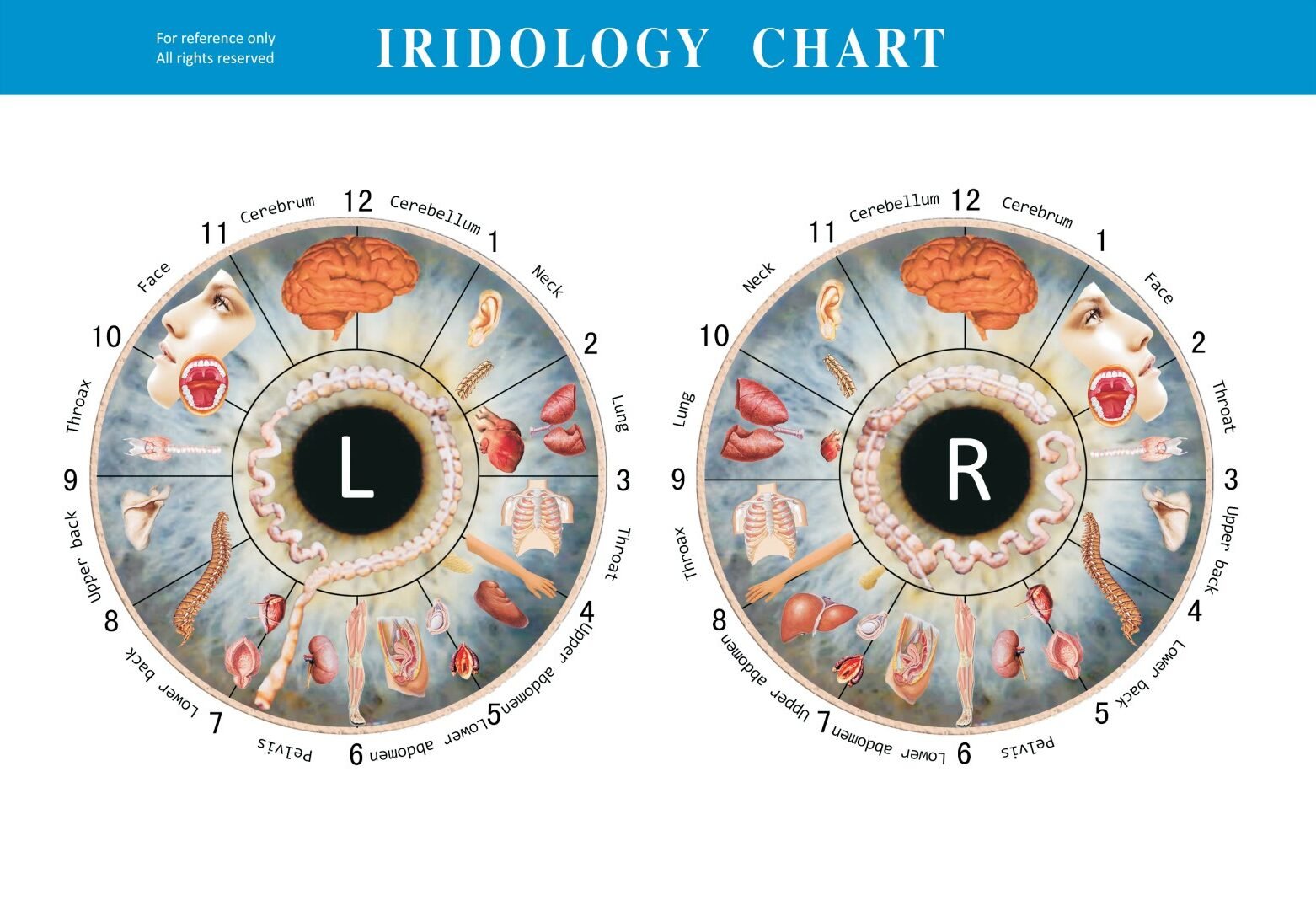Iridology is a fascinating alternative health practice that examines patterns, colors, and other characteristics of the iris to evaluate a person’s overall health. At the center of this practice is the iridology eye chart – a detailed map that practitioners use to connect specific regions of the iris with corresponding body systems and organs. This guide will walk you through the fundamentals of iridology charts, how to read them, and what science has to say about this intriguing but controversial practice.A typical iridology eye chart mapping iris regions to corresponding body systems
What Is an Iridology Eye Chart?
An iridology eye chart serves as a map that divides the iris into multiple zones, each corresponding to different parts of the human body. These charts are essential tools for iridologists who analyze the iris to identify potential health concerns before they manifest as physical symptoms.
The modern tableau d'iridologie was developed in the 1950s by American chiropractor Bernard Jensen, though the practice itself dates back to the 19th century when Hungarian physician Ignaz von Peczely first documented correlations between iris markings and health conditions. Today, these charts remain fundamental to the practice of iridology worldwide.


Bernard Jensen’s influential iridology chart that is still widely used today
Anatomy of an Iridology Chart
Iridology charts typically divide each iris into approximately 80-90 zones, creating a detailed map that correlates to various body systems. Understanding the basic structure of these charts is essential for anyone interested in this holistic practice.
Zones and Regions
The iris is divided into several concentric rings and pie-shaped sectors. Each zone corresponds to a specific organ or body system. The chart is organized like a clock face, with each “hour” representing different body parts. For example, the liver typically appears in the right iris between the 8 and 9 o’clock positions.


Clock-like divisions of an iridology chart showing organ correspondences
Left and Right Eye Differences
In iridology, the left and right irises represent different sides of the body:
Iris droit
- Corresponds to the right side of the body
- Top region: Brain, head, and sinuses
- Upper quadrants: Lungs and heart
- Middle area: Liver, gallbladder, pancreas
- Lower region: Kidneys, intestines, reproductive organs
Iris gauche
- Corresponds to the left side of the body
- Top region: Cerebral circulation, mental function
- Upper quadrants: Spleen, stomach, lymphatic system
- Middle area: Small intestine, colon, spine
- Lower region: Bladder, reproductive system
Colors and Markings
Iridology charts also include interpretations for various colors and markings found in the iris:
| Marking/Color | Interpretation in Iridology |
| White streaks | Inflammation ou hyperactivité de l'organe concerné |
| Taches sombres | Possible toxic accumulation or damage |
| Blue or gray iris | Often associated with a weaker immune system |
| Brown or dark iris | May indicate liver or digestive system tendencies |
| Yellow rings | Potential kidney or urinary tract issues |
| Lignes radiales | Circulation or nerve energy pathways |
How to Read an Iridology Eye Chart
Reading an tableau d'iridologie requires practice and attention to detail. Here’s a step-by-step guide for beginners interested in understanding the basics of this practice:

Step-by-step process for reading an iridology chart
Step 1: Identify the Iris Type
Before analyzing specific markings, identify the basic iris type. The three main types are:
- Lymphatique (Iris bleu) – Associated with lymphatic system and potential kidney issues
- Hématogène (brown/amber iris) – Associated with blood and liver functions
- Mixed (combination) – Shows characteristics of both types
Step 2: Locate the Pupillary Zone
The area immediately surrounding the pupil is called the autonomic nerve wreath. This zone represents the digestive system and is often the starting point for iris analysis.
Step 3: Map Sectors to Body Systems
Using your iridology chart as a reference, identify which sectors correspond to which body systems. Remember that the right iris corresponds to the right side of the body, and the left iris to the left side.
Step 4: Analyze Markings and Colors
Look for specific markings in each zone and interpret them according to iridology principles. Common markings include:
- Lacunae (dark spots or holes)
- Radii solaris (lines radiating from the pupil)
- Pigment spots (colored spots in the iris)
- Rings (circular patterns around the iris)



Common iris markings and their interpretations in iridology
Step 5: Document Your Findings
Record your observations systematically, noting the location and characteristics of each marking. This documentation helps track changes over time.
Want to Learn More About Holistic Health Practices?
Discover how different natural health approaches can complement your wellness journey. Always consult with qualified health professionals before making health decisions based on alternative practices.
Explorez les ressources de santé holistique
Common Symbols and Their Meanings in Iridology Charts
Iridology charts include various symbols that represent different health conditions. Understanding these symbols is crucial for accurate interpretation.



Common symbols found on iridology charts and their interpretations
Anneaux nerveux
Concentric circles appearing in the iris that may indicate stress, tension, or nervous system pressure. The more pronounced the rings, the more significant the stress response.
Lymphatic Rosaries
White dots arranged in a circular pattern that may suggest lymphatic system congestion or immune system challenges.
Jante de scurf
A dark ring around the outer edge of the iris that iridologists associate with skin elimination issues or potential toxin accumulation.
Sillons radiaux
Lines extending from the pupil to the outer iris that may indicate circulation issues or energy flow disruptions to specific organs.

Radial furrows in an iris and their significance in iridology
Taches de pigment
Colored spots in the iris that may represent mineral deposits or chemical accumulations according to iridology theory.
Scientific Validity of Iridology
While iridology has many dedicated practitioners and followers worldwide, it’s important to understand the scientific perspective on this practice.
Réclamation des partisans
- The iris can reveal early warning signs of health issues
- Patterns in the iris correspond to specific body systems
- Iridology can detect predispositions to certain conditions
- It offers a non-invasive way to assess overall health
Préoccupations scientifiques
- Limited peer-reviewed research supporting iridology claims
- Controlled studies have not validated diagnostic accuracy
- The iris structure remains largely stable throughout life
- Medical organizations do not recognize iridology as diagnostic
A study published in 2000 concluded that “iridology had no clinical or diagnostic utility.” Similarly, most medical professionals maintain that while the iris can reveal certain eye conditions, it cannot reliably indicate disorders in other parts of the body.
Remarque importante: Iridology should not replace conventional medical diagnosis or treatment. Always consult with qualified healthcare providers for health concerns.
Applications pratiques des graphiques iridologiques
Despite scientific skepticism, many holistic health practitioners continue to use iridology charts as part of their practice. Here are some common applications:

A holistic health practitioner using iridology as part of a wellness assessment
Évaluation complémentaire
Some practitioners use iridology as one component of a broader holistic health assessment, combining it with other approaches like nutritional analysis and lifestyle evaluation.
Preventive Guidance
Iridology is sometimes used to identify potential areas of weakness, allowing practitioners to suggest preventive measures before symptoms develop.
Tracking Changes
Some iridologists document iris changes over time to monitor how lifestyle modifications or treatments may be affecting overall health patterns.

Before and after iris photographs showing changes that iridologists might track
Educational Tool
Iridology charts are often used as educational tools to help people understand the holistic concept of body interconnectedness, even if not used for specific diagnosis.
Choosing the Right Iridology Eye Chart
If you’re interested in exploring iridology, selecting an appropriate chart is an important first step. Here are some considerations:

Comparison of different iridology chart styles and detail levels
Chart Types
Several types of iridology charts are available, each with different levels of detail:
- Basic Charts – Suitable for beginners, showing main body systems and organs
- Detailed Clinical Charts – Used by practitioners, containing extensive subdivisions
- Specialized Charts – Focus on specific systems like digestive or lymphatic
Quality Considerations
When selecting an iridology chart, look for:
- Clear, high-resolution images
- Detailed labeling of all zones
- Color-coding for easier interpretation
- Charts from established iridology schools or practitioners
Digital vs. Physical Charts
Consider whether a physical chart or digital application better suits your needs. Digital options often offer zoom capabilities and interactive features, while physical charts provide a tangible reference.
Conclusion: The Role of Iridology Charts in Holistic Health
Iridology eye charts represent a fascinating intersection of ancient observation and alternative health practices. While scientific validation remains limited, many continue to find value in this holistic approach to understanding the body’s interconnected systems.
Whether you’re a curious learner or someone interested in complementary health approaches, understanding iridology charts can provide insight into this unique practice. However, it’s crucial to approach iridology with a balanced perspective, recognizing both its limitations and the reasons for its enduring appeal in holistic health communities.

Always discuss alternative health findings with qualified healthcare professionals
Interested in Holistic Health Approaches?
While iridology offers an interesting perspective on health, always consult with qualified healthcare professionals for medical concerns. Consider exploring evidence-based complementary approaches alongside conventional care.
Find a Qualified Health Professional
L'iridologie peut-elle diagnostiquer des maladies spécifiques?
Iridology is not recognized by conventional medicine as a diagnostic tool for specific diseases. While practitioners may identify patterns they associate with certain conditions, scientific studies have not validated these correlations. Always seek proper medical diagnosis for health concerns.
How long does it take to learn to read an iridology chart?
Learning the basics of iridology chart reading can take several months, while becoming proficient may require years of study and practice. Many practitioners complete formal training programs that include supervised clinical experience.
Are there any risks associated with iridology?
The examination itself is non-invasive and poses no direct physical risks. However, there is a potential risk if someone relies exclusively on iridology instead of seeking appropriate medical care for serious health conditions. Always use iridology as a complement to, not a replacement for, conventional healthcare.



















